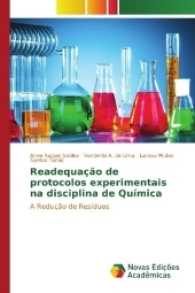- ホーム
- > 洋書
- > 英文書
- > Science / Mathematics
Full Description
Since the pioneering publications on coordination chemistry by Lehn and Pedersen in the late 1960s, coupled with the more orthodox interest from the transition metal chemists on template reactions (Busch, 1964), the field of supramolecular chemistry has grown at an astonishing rate. The use of transition metals as essential constituents of multi-component assemblies has been especially sharp in recent years, since the metals are prone to quick and reversible redox changes, and there is a wide variety of metal--ligand interactions. Such properties make supramolecular complexes of transition metal ions suitable candidates for exploration as light--energy converters and signal processors.
Transition Metals in Supramolecular Chemistry focuses on the following main topics: (1) metal controlled organization of novel molecular assemblies and shapes; (2) design of molecular switches and devices operating through metal centres; (3) supramolecular catalysts that mimic metalloenzymes; (4) metal-containing sensory reagents and supramolecular recognition; and (5) molecular materials that display powerful electronic, optoelectronic and magnetic properties.
Contents
Supramolecular photochemistry and photophysics. Energy conversion and information-processing devices based on transition metal complexes.- Transition metal redox active ligand systems for recognising cationic and anionic guest species.- Ligand design for enhanced molecular organization — selectivity and specific sequencing in multiple receptor ligands, and orderly molecular entanglements.- Metal-ions: a self-assembly motif in supramolecular oligomers.- Biomedical targeting: a role for supramolecular chemistry.- Redox chemistry of metal ion complexes: preparation of new materials.- pH and redox switches based on metal centres.- Schiff base macrocycles and metallo-biosite modelling.- Self-assembly of mono- and dinuclear metal complexes; oxidation catalysis and metalloenzyme models.- Artificial porphyrins containing cyclopropane units functioning as electron shuttles.- Homo- and heterobinuclear metal complexes with bismacrocyclic ligands.- Ferrocene as a building block for supramolecular chemistry systems.- Macrocyclic polyamine complexes beyond metalloenzyme models.- Towards molecular wires and switches: exploiting coordination chemistry for non-linear optics and molecular electronics.- Molecular interactions between metalloproteins involved in electron transfer processes: tetraheme cytochrome c3 and flavodoxin. NMR and molecular modeling studies.- Supramolecular models of metallo-proteins.- The role of macrocyclic receptors in organization of metal centres.- Metallomacrocycles and -clefts: receptors for neutral molecules and anions.- Chiral recognition by functionalized cyclodextrin metal complexes.- Transition metal-directed threading and knotting processes.- Expanded porphyrins. Receptors for cationic, anionic and neutral substrates.- Following the self-assemblyprocess in solution.- Author Index.








